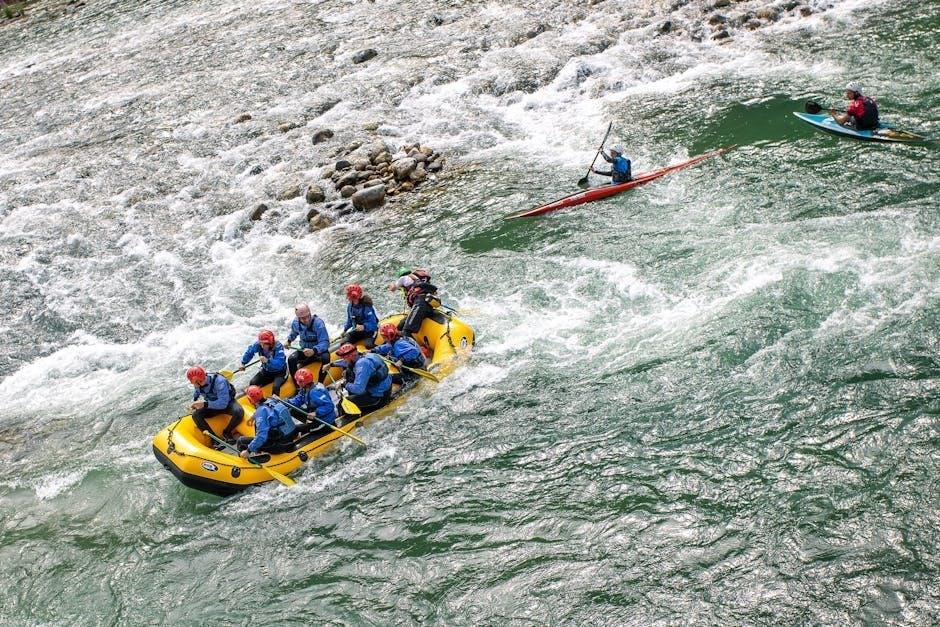Kayak sizing is crucial for optimal performance, stability, and comfort. Choosing the right size ensures proper fit, enhancing paddling efficiency and overall enjoyment. Proper sizing considers factors like paddler weight, height, and intended use, ensuring a safe and enjoyable experience on the water.
1.1 Importance of Choosing the Right Kayak Size
Choosing the right kayak size is essential for stability, control, and comfort. A properly sized kayak ensures optimal performance, reducing fatigue and enhancing maneuverability. It also improves safety, as a kayak that fits your weight and height distributes load evenly, preventing tipping. Additionally, the right size maximizes efficiency, allowing you to paddle longer distances with less effort; Ignoring size considerations can lead to poor handling and discomfort, making the experience less enjoyable. Always prioritize fit to ensure a safe and rewarding paddling experience tailored to your needs and the water conditions you plan to encounter.
1.2 Brief History of Kayak Design and Sizing
Kayak design has evolved significantly over centuries, originating from Indigenous peoples who crafted them for survival. Early kayaks were made of wood and animal skins, with sizes tailored to specific tasks like hunting or transportation. The Inuit designed them for maneuverability in icy waters, emphasizing lightweight yet durable construction. Modern materials like fiberglass and plastic revolutionized kayak sizing, enabling mass production and diverse designs. Today, kayaks vary in length, width, and weight capacity to suit recreational, touring, or competitive purposes. This evolution reflects a balance between traditional functionality and contemporary performance needs, ensuring kayaks meet diverse paddling demands effectively. Their history underscores the importance of size in optimizing usability and efficiency for varying water conditions and user preferences.

Factors Influencing Kayak Size
Kayak size is influenced by paddler experience, intended use, and physical attributes like height and weight. These factors ensure optimal performance, stability, and comfort on the water.
2.1 Paddler Experience Level
A paddler’s experience level significantly impacts kayak size selection. Beginners benefit from stable, wider kayaks for better balance, while experienced paddlers may prefer narrower, faster models for agility and speed. Novice kayakers often prioritize ease of handling and forgiveness in rough waters, whereas skilled paddlers might opt for performance-oriented designs that allow for advanced maneuvering. The length and width of the kayak should align with the paddler’s skill level to ensure comfort and control, making the paddling experience enjoyable and safe. Proper sizing enhances performance and confidence, whether on calm lakes or challenging rapids.
2.2 Intended Use of the Kayak
The intended use of the kayak plays a pivotal role in determining its size. Recreational kayaks, designed for calm waters, are typically shorter and wider for stability and ease of maneuverability. Touring kayaks, built for long-distance trips, are longer and narrower to enhance speed and efficiency. Whitewater kayaks are shorter and more agile to navigate rapids effectively. Fishing kayaks often feature wider beams for stability and additional storage space for gear. Each use case requires specific dimensions to optimize performance, ensuring the kayak meets the demands of its intended environment and activity. Proper sizing ensures safety, comfort, and functionality.
2.3 Paddler Height and Weight
Paddler height and weight significantly influence kayak size selection. Taller paddlers require more legroom, while lighter individuals may prefer a smaller, more maneuverable kayak. Weight capacity is crucial for stability and performance. Exceeding the recommended weight limits can compromise buoyancy and control. Ensure the kayak’s weight capacity accommodates both the paddler and any additional gear. Proper fit based on height ensures comfort and ease of paddling. Consulting a sizing chart specific to the kayak model and intended use is essential for optimal fit and performance. Balancing these factors ensures a safe and enjoyable paddling experience tailored to individual needs and preferences.

Key Measurements in Kayak Sizing
Key measurements include length, width, depth, and weight capacity. These dimensions ensure proper fit, stability, and performance, catering to diverse paddling needs and preferences effectively.
3.1 Length of the Kayak
The length of a kayak significantly impacts its performance. Longer kayaks, typically over 12 feet, offer greater speed and tracking ability, making them ideal for touring or covering long distances. Shorter kayaks, under 10 feet, provide excellent maneuverability, suitable for whitewater or recreational use in tight spaces. A mid-length kayak, around 10-12 feet, balances speed and agility, catering to casual paddlers. Understanding your paddling needs helps determine the optimal length, ensuring a kayak that performs well in your preferred environment, whether it’s calm lakes or dynamic rivers.
3.2 Width of the Kayak
The width of a kayak plays a key role in determining stability and maneuverability. Wider kayaks, typically 24–36 inches, provide greater stability, making them ideal for beginners, fishing, or recreational use. Narrower kayaks, often 20–24 inches, sacrifice some stability for increased speed and efficiency, appealing to experienced paddlers. The width also affects the kayak’s tracking ability and how easily it can navigate tight spaces. A wider kayak offers better balance in calm waters, while a narrower one excels in dynamic or fast-moving conditions. Choosing the right width ensures a balance of stability and performance tailored to your paddling style and environment.
3.3 Depth of the Kayak
The depth of a kayak, measured from top to bottom, impacts legroom, storage, and overall comfort; Deeper kayaks, typically 12–18 inches, provide ample legroom and storage space, ideal for touring or expedition use. Shallower depths, around 8–12 inches, reduce weight and enhance maneuverability, suitable for whitewater or recreational paddling. Adequate depth ensures proper seating and leg positioning, preventing discomfort during long trips. It also influences the kayak’s buoyancy and how it handles varying water conditions. Balancing depth with other measurements ensures optimal performance, comfort, and functionality for specific paddling needs and environments. Proper depth selection is vital for an enjoyable kayaking experience.
3.4 Weight Capacity
Weight capacity is a critical factor in kayak sizing, ensuring safety and performance. It refers to the maximum weight a kayak can support, including paddler, gear, and accessories. Exceeding this limit can compromise stability, maneuverability, and buoyancy, leading to poor handling and potential hazards. Manufacturers provide specific weight ratings for each model, tailored to paddler weight, intended use, and water conditions. Selecting a kayak with an appropriate weight capacity ensures optimal performance, comfort, and safety. Always consider your weight and the gear you plan to carry when choosing a kayak to stay within recommended limits and enjoy a secure paddling experience.
How to Choose the Right Kayak Size
Selecting the right kayak size involves assessing your paddling needs, skill level, and body measurements. Consider length, width, and weight capacity for stability, speed, and comfort. Test models before purchasing to ensure the best fit and performance for your adventures.
4.1 Assessing Your Paddling Needs
Assessing your paddling needs is the first step in choosing the right kayak size. Determine the primary use of the kayak—whether it’s for calm lakes, open oceans, or whitewater rapids. Consider your experience level; beginners may prefer more stability, while experienced paddlers might prioritize speed and maneuverability. Think about the frequency of use and the typical duration of trips. Additionally, reflect on the type of activities you’ll be doing, such as fishing, touring, or recreational paddling. Understanding your needs ensures the kayak fits your lifestyle and enhances your paddling experience.
4.2 Understanding Kayak Stability
Understanding kayak stability is essential for selecting the right size and type. Primary stability refers to how stable the kayak feels when upright, while secondary stability determines its stability when leaned. A wider kayak generally offers greater primary stability, making it ideal for beginners or calm waters. Narrower kayaks may feel less stable initially but often excel in secondary stability, allowing for better maneuverability and performance in rough conditions. Balancing these factors based on your paddling environment and skill level ensures a safe and enjoyable experience on the water.
4.3 Balancing Speed and Maneuverability
Balancing speed and maneuverability is key when choosing a kayak size. Longer kayaks with narrower widths typically offer greater speed and tracking efficiency, making them ideal for touring or covering long distances. Shorter, wider kayaks, however, prioritize maneuverability, excelling in tight spaces or whitewater conditions. The hull design also plays a role, with rounded hulls enhancing speed and flat hulls improving stability. Paddlers must consider their primary use and skill level to strike the right balance, ensuring their kayak meets performance needs without sacrificing ease of handling. This balance is crucial for an enjoyable and efficient paddling experience.

Kayak Size Considerations for Specific Activities
Kayak size varies by activity, with recreational kayaks favoring stability, touring kayaks emphasizing length for speed, and whitewater kayaks prioritizing maneuverability. Each design caters to specific needs.
5.1 Recreational Kayaking
Recreational kayaks are designed for calm waters like lakes, slow rivers, or coastal areas. They prioritize stability and ease of use, making them ideal for beginners or casual paddlers. These kayaks are typically wider and shorter, ranging from 8 to 12 feet in length, with a sturdy design for smooth maneuverability. Their larger cockpits provide easy entry and exit, while the flat bottom enhances balance. Recreational kayaks are durable and lightweight, often with sufficient storage for day trips. They are perfect for those seeking a relaxing or fishing experience, offering comfort and versatility for various water conditions.
5.2 Touring and Expedition Kayaking
Touring and expedition kayaks are designed for long-distance paddling on open water, emphasizing efficiency and tracking. These kayaks are typically longer (14-18 feet) and narrower, with a streamlined design for speed. They feature ample storage space for multi-day trips, with hatches and compartments to secure gear. A strong, durable construction withstands rough conditions, while a V-shaped or rounded hull enhances stability and tracking. Weight capacity is crucial, accommodating paddlers, gear, and often a second person in tandem models. These kayaks are ideal for experienced paddlers seeking adventure in challenging environments, offering a balance of performance, comfort, and reliability for extended journeys.
5.3 Whitewater and Rapids Kayaking
Whitewater and rapids kayaks are built for agility and maneuverability in fast-moving water. These kayaks are shorter (6-10 feet) and highly responsive, with a rounded hull for quick turns and playfulness. Designed for experienced paddlers, they prioritize stability in turbulent conditions while maintaining River-running capability. Weight capacity is less critical than in touring kayaks, as they are optimized for single paddlers. Durable materials and self-bailing systems are essential for withstanding impacts and keeping the kayak dry. These kayaks excel in dynamic environments, offering thrill-seekers precise control and adaptability in challenging whitewater scenarios. Their compact size enhances performance in tight river sections and rapids.
5.4 Fishing and Hunting Kayaks
Fishing and hunting kayaks are designed for stability and cargo capacity, often longer and wider than recreational kayaks. Their stable platforms allow anglers to stand and cast comfortably. These kayaks typically range from 10-14 feet in length, with flat bottoms and wide beams for excellent balance. Weight capacity is crucial, as they need to hold gear, equipment, and sometimes a second person. Features like built-in rod holders, storage compartments, and mounts for accessories are common. Durable construction withstands rough use, and sit-on-top designs provide easy access for fishing and hunting activities. They are ideal for calm waters like lakes and bays.
Understanding Kayak Types and Their Sizes
Kayaks vary by type, including inflatable, sit-on-top, sit-inside, and tandem models. Each type offers unique benefits, such as portability, stability, or shared paddling experiences, catering to diverse needs and water conditions.
6.1 Inflatable Kayaks
Inflatable kayaks are lightweight and portable, making them ideal for travelers. They feature durable materials like PVC and often come with adjustable seats for comfort. These kayaks are easy to store and transport, perfect for calm waters such as lakes or slow-moving rivers. Their compact design allows for easy handling, and they are generally more affordable than traditional kayaks. Despite being inflatable, they offer decent stability and are great for recreational use. However, they may lack the speed and tracking of rigid kayaks, making them less suitable for long-distance touring or rough waters.
6.2 Sit-On-Top Kayaks
Sit-on-top kayaks are popular for their versatility and ease of use. They feature an open deck design, making them ideal for casual paddling, fishing, or swimming. These kayaks are self-bailing, with scupper holes that drain water automatically. They are generally wider, providing excellent stability, and are suitable for beginners or those who prioritize comfort. Sit-on-top kayaks are lightweight and easy to maneuver, with lengths typically ranging from 10 to 12 feet and widths between 30 to 34 inches. They are durable, often made from high-density polyethylene, and offer ample storage space. Their open design allows for easy access and is perfect for warm weather or shallow waters.
6.3 Sit-Inside Kayaks
Sit-inside kayaks offer a traditional paddling experience with a cockpit design. They are ideal for experienced paddlers seeking better control and efficiency. These kayaks are typically narrower and longer, enhancing speed and tracking. They are suitable for touring, expedition, or whitewater kayaking. Sit-inside kayaks require proper fitting, as the paddler’s legs are inside the hull; They usually range from 12 to 18 feet in length and 20 to 24 inches in width. They are lightweight, often made from materials like fiberglass or carbon fiber, and provide excellent maneuverability; Their enclosed design offers protection from the elements, making them perfect for cold weather or long-distance trips.
6.4 Tandem Kayaks
Tandem kayaks are designed for two paddlers, offering a shared paddling experience. They are longer and wider than single kayaks, typically ranging from 14 to 18 feet in length and 30 to 36 inches in width. This design enhances stability and accommodates varying paddler weights, usually up to 500-600 pounds. Tandem kayaks are ideal for recreational use, fishing, or family outings, promoting teamwork and communication between paddlers. They often feature adjustable seats and footrests for comfort. While they are heavier and less maneuverable than single kayaks, tandem models provide a fun and social way to enjoy kayaking together.

Measuring Yourself for a Kayak
Accurately measure your height, weight, and paddling style to ensure a proper kayak fit and optimal performance on the water. Consider comfort and adjustments for the best experience.
7.1 Measuring Your Height and Weight
Measuring your height and weight is essential for selecting the right kayak size. Stand against a wall to record your height accurately. Weigh yourself on a reliable scale. These measurements help determine the kayak’s weight capacity and cockpit size. Ensure the kayak supports your weight for stability and performance. Proper fit prevents strain and enhances paddling efficiency. Accurate measurements are crucial for a safe and enjoyable kayaking experience. Consider your build and any additional gear weight when evaluating kayak specifications. This step ensures a comfortable and efficient paddling experience tailored to your needs.
7.2 Considering Your Paddling Style
Your paddling style significantly influences kayak size selection. Beginners may prefer a stable, forgiving design, while experienced paddlers might opt for sleeker, faster models; Consider your stroke efficiency, posture, and preferred paddling frequency. Consider whether you paddle casually or aggressively, as this impacts the kayak’s responsiveness. Additionally, think about the water conditions you frequent—calm lakes, choppy seas, or tight rivers. Your paddling style determines the ideal length, width, and cockpit size for comfort and performance. Matching your style to the kayak ensures a more enjoyable and efficient paddling experience. Evaluate these factors to make an informed choice.

Top Brands and Their Sizing Charts
Top kayak brands provide detailed sizing charts to help paddlers choose the right model. These charts consider height, weight, and intended use for optimal fit and performance.
8.1 Brand A Sizing Guide
Brand A offers a comprehensive sizing guide tailored to paddlers of all levels. Their charts categorize kayaks by length, width, and weight capacity, ensuring a perfect match for any paddler. Detailed tables provide recommendations based on paddler height and weight, while also considering the intended use of the kayak. Whether for recreational, touring, or whitewater adventures, Brand A’s guide helps users find a kayak that balances speed, stability, and maneuverability. This ensures optimal performance and comfort, making it easier for paddlers to select the right model for their needs.
8.2 Brand B Sizing Guide
Brand B’s sizing guide emphasizes a personalized approach, focusing on the paddler’s specific needs and preferences. Their detailed charts and interactive tools help users determine the ideal kayak size by considering factors like paddling style, frequency of use, and water conditions. The guide also provides weight capacity ranges and recommendations for kayak length and width, ensuring stability and performance. Brand B’s user-friendly interface makes it easy to navigate and find the perfect kayak model, catering to both novice and experienced paddlers. This tailored approach ensures a seamless selection process, enhancing overall satisfaction and paddling experience.
8.3 Brand C Sizing Guide
Brand C’s sizing guide prioritizes simplicity and clarity, offering a straightforward approach to selecting the right kayak. Their chart-based system categorizes kayaks by length, width, and weight capacity, tailored to specific activities like recreational, touring, or whitewater kayaking. The guide also includes a height-to-kayak-length ratio, ensuring proper fit and comfort. Brand C emphasizes durability and performance, with recommendations based on paddling frequency and skill level. By focusing on ease of use and practical advice, Brand C’s guide helps paddlers make informed decisions, ensuring their kayak meets their unique needs and enhances their on-water experience with optimal performance and comfort.
Common Mistakes When Choosing a Kayak Size
Common mistakes include ignoring weight capacity, overlooking paddler comfort, and prioritizing speed over stability. Ensure proper fit by considering height, weight, and intended use to avoid poor performance.
9.1 Ignoring Weight Capacity
Ignoring weight capacity is a common mistake that can lead to poor kayak performance. Exceeding the recommended weight limits can cause the kayak to sit too low in the water, affecting stability and speed. This oversight can also increase the risk of tipping, especially in rough conditions. Always check the manufacturer’s guidelines to ensure the kayak can safely support both the paddler and any additional gear. Proper weight distribution is essential for a safe and enjoyable paddling experience, so never overlook this critical factor when selecting your kayak.
9.2 Overlooking Paddler Comfort
Overlooking paddler comfort is a significant mistake when choosing a kayak. A kayak that doesn’t fit the paddler’s body can lead to discomfort, fatigue, and even pain during extended trips. Key factors like seat design, footrests, and legroom are often ignored but play a crucial role in ensuring a pleasant paddling experience. Poor ergonomics can cause strain on the back, knees, and shoulders, making it difficult to maintain proper paddling form. Always prioritize a kayak with adjustable features and a design that supports your body type to avoid discomfort and ensure enjoyable outings on the water.
9.3 Prioritizing Speed Over Stability
Prioritizing speed over stability is a common mistake when selecting a kayak. While faster kayaks may appeal to experienced paddlers, they often compromise stability, making them unsuitable for beginners or calm water enthusiasts. Kayaks with narrower widths and longer lengths enhance speed but can be challenging to maneuver for those still learning. Stability is crucial for confidence-building and safety, especially in rough or unpredictable conditions. Balancing speed and stability ensures a more enjoyable and secure paddling experience, catering to both skill level and intended use, whether exploring serene lakes or navigating choppy seas.

Maintenance and Care of Your Kayak
Regular cleaning, proper storage, and protection from UV exposure are essential for maintaining your kayak’s condition. This ensures longevity and optimal performance on the water.
10.1 Cleaning and Storage Tips
Proper cleaning and storage are vital for maintaining your kayak’s durability. After each use, rinse the kayak with fresh water to remove dirt and salt residue. For tougher stains, use a mild soap and soft brush. Avoid harsh chemicals that can damage the hull material. When storing, keep the kayak in a dry, shaded area to prevent UV damage. Use a sturdy rack or padded surface to avoid dents. For inflatable kayaks, ensure they are completely dry before storage to prevent mold. Regular maintenance ensures your kayak remains in excellent condition for years of enjoyment.
10.2 Repairing Scratches and Damages
Minor scratches on your kayak can be addressed with a UV-resistant protectant or wax to prevent further damage. For deeper cracks or punctures, use a kayak repair kit specifically designed for your kayak’s material. Clean the damaged area thoroughly and apply the repair compound as instructed. Allow it to dry completely before testing the kayak in water. For severe damage, consult a professional or the manufacturer. Regular inspections and timely repairs will extend your kayak’s lifespan and ensure safety. Always follow the manufacturer’s guidelines for repair materials and techniques to maintain the kayak’s structural integrity and performance.
Choosing the right kayak size is essential for comfort, stability, and performance. By considering factors like fit, paddling style, and intended use, you can make an informed decision. Always test different models before purchasing to ensure the best experience on the water.
11.1 Final Thoughts on Kayak Sizing
11.2 Encouragement to Try Before Buying
Testing a kayak before purchasing is essential to ensure it meets your needs and preferences. Visit a retailer or rental service to experience different models firsthand. This hands-on approach allows you to assess comfort, handling, and performance in real conditions. Pay attention to how the kayak glides, turns, and responds to your movements. A proper fit is crucial for efficiency and safety. Don’t hesitate to ask for guidance from experts or fellow paddlers. Trying before buying ensures you make an informed decision, avoiding costly mistakes. It’s a simple step that can greatly enhance your kayaking experience and overall satisfaction.